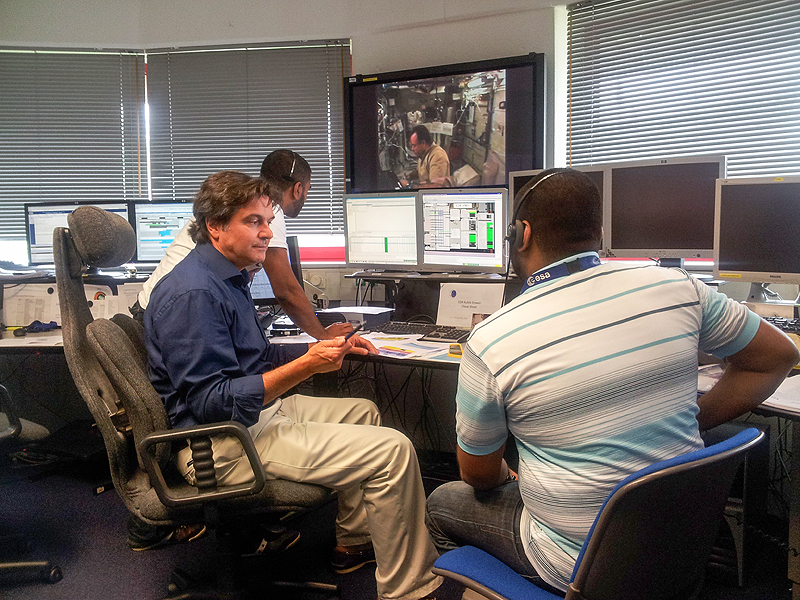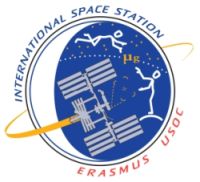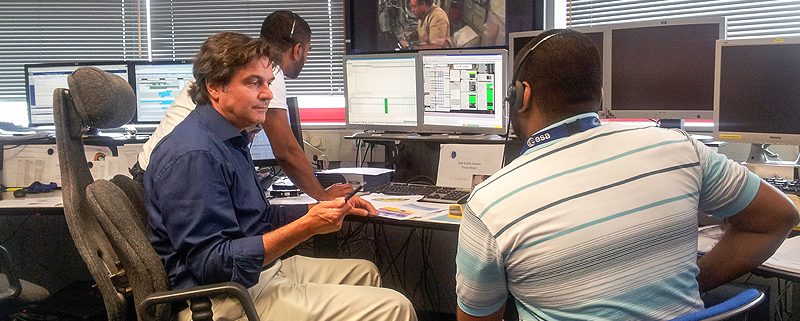
Photo:Â Erasmus USOC control room during ERB2 operators with specialistes from NLR and SAS providing support to payload coordinator from ESA
Last summer, the first live 3D High Definition video images in the history of space travel were received by the Erasmus User Support and Operations Centre (USOC) at the ESTEC in the Netherlands. Erasmus USOC is manned by specialists from the National Aerospace Laboratory (NLR) and Space Applications Services (SAS). These specialists will continue to prepare and support live streaming events. 3D images take the viewers to inside the International Space Station (ISS) as if they were really there, and contribute to increasing awareness of the ISS programme. The video images can also be used in mission planning and to support operations inside the ISS. The images were taken using the Erasmus Recording Binoculars (ERB2) camera.
During the live-streaming video event ERB2 was connected to the European Drawer Rack (EDR) for which the Erasmus USOC is the Facility Responsible Centre.
EDR is a flexible, experimental workbench for various scientific disciplines on board in the Columbus, the European module attached to the International Space Station since February 2008. The video data is transferred to ground as science data, using the Station’s High Rate Data Link. Via ground stations in the United States and the Columbus Control Centre near Munich, Germany, the video data arrives at the Erasmus USOC in Noordwijk, the Netherlands. Erasmus USOC transfers the video data to the ERB2 User Home Base (UHB), also located in the Erasmus building at ESTEC, which processes the video data such that it can be shown in the Erasmus auditorium.
NLR specialists at Erasmus USOC ensure that the 3D images from the ISS are transferred to the Payload Coordinator at ESA for further processing. Erasmus USOC supports all ERB2 3D camera-operations, including development, validation and test of operational procedures, and planning of the operations. The ERB2 3D camera is not only used for live streaming, but also for free use by the ISS crew. These videos are downloaded via EDR at a later time.
The first 3D video stream was of impressive quality, and can be watched on YouTube: http://www.youtube.com/watch?v=riJ0eHTCeig . The video has already been watched over 270.000 times, more than any other ESA video so far!
 USOCs are considered as vitally important for gaining the best results from European scientific experiments on-board the ISS. Specialists from the National Aerospace NLR and SAS, operate the Erasmus USOC. They provide assistance to the astronauts when they conduct their scientific experiments and serve as intermediate to Principal Investigators and science teams towards the ISS operations. When required, USOC operations are performed 24 hours a day, including, as in this case, during the weekend.
USOCs are considered as vitally important for gaining the best results from European scientific experiments on-board the ISS. Specialists from the National Aerospace NLR and SAS, operate the Erasmus USOC. They provide assistance to the astronauts when they conduct their scientific experiments and serve as intermediate to Principal Investigators and science teams towards the ISS operations. When required, USOC operations are performed 24 hours a day, including, as in this case, during the weekend.
The Erasmus USOC operations were performed under a contract between ESA and NLR, with a subcontract to SAS. The Erasmus USOC has been built up by contributions from Dutch and Belgium government.


